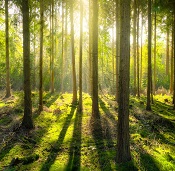La dinámica de los árboles de sombra en los agrosistemas de cacao
Contenido principal del artículo
La presencia de diversos árboles de sombra en los agrosistemas de cacao permite la creación de hábitats adecuados para las especies de vida silvestre, lo que les permite prosperar en el entorno de la plantación. El objetivo de esta investigación es calcular los índices de similitud de árboles de sombra utilizados en agrosistemas cacaoteros en la región de Comalcalco, Tabasco, México. Se realizó un muestreo de campo para recolectar datos sobre el diámetro de la altura del pecho, el diámetro del dosel y la altura del dosel, estas variables se utilizaron para calcular los índices de similitud de Sorensen y Morisita-Horn. La similitud entre los sitios de estudio, el índice cualitativo de Sorensen muestra que SA 1 - SA 2 son los más similares en composición de especies, SA 1 - SA 2 con 27.46 % de similitud, seguido de SA 2 - SA 3 con 27.27 %, mientras que SA 1 - SA 3 son los sitios con una estructura menos similar del 26,52%. El papel de los árboles de sombra en los agrosistemas de cacao es importante, ya que puede servir como variable para evaluar y predecir la calidad de los hábitats disponibles para la conservación de la vida silvestre, incluidas aves, reptiles y mamíferos arbóreos, utilizando técnicas de modelado de nichos ecológicos.
- índices de biodiversidad
- variables dasométricas
- árboles de sombra.
McDermott, M. E., Rodewald, A. D., & Matthews, S. N. (2015). Managing tropical agroforestry for conservation of flocking migratory birds // Agroforestry Systems, 89(3), 383-396.
https://doi.org/10.1007/s10457-014-9777-3.
Bisseleua, D. H. B., Missoup, A. D., & Vidal, S. (2009). Biodiversity conservation, ecosystem functioning, and economic incentives under cocoa agroforestry intensification // Conservation biology, 23(5), 1176-1184. doi: 10.1111/j.1523-1739.2009.01220.x
https://doi.org/10.1111/j.1523-1739.2009.01220.x
Greenberg, R. (2014). Biodiversity in the Cacao Agroecosystem: Shade Management and Landscape Considerations // Migratory Bird Center Website. Smithsonian Institution, Washington, DC, 1-12.
Cattanio, J. H., Anderson, A. B., & Carvalho, M. S. (2002). Floristic composition and topographic variation in a tidal floodplain forest in the Amazon Estuary // Brazilian Journal of Botany, 25, 419-430.
https://doi.org/10.1590/S0100-84042002012000006
Ordoñez, C. M., & Rangel-Ch, J. O. (2020). Composición florística y aspectos de la estructura de la vegetación en sistemas agroforestales con cacao (Theobroma cacao L.-Malvaceae) en el departamento del Huila, Colombia // Revista de la Academia Colombiana de Ciencias Exactas, Físicas y Naturales, 44(173), 1033-1046. doi: 10.18257/raccefyn.1183
https://doi.org/10.18257/raccefyn.1183
Somarriba, E., & Orozco Aguilar, L. (2005). Árboles maderables en fincas de cacao orgánico del Alto Beni, Bolivia // Agroforestería en las Américas.
Sonwa, D. J., Weise, S. F., Nkongmeneck, B. A., Tchatat, M., & Janssens, M. J. (2017). Structure and composition of cocoa agroforests in the humid forest zone of Southern Cameroon // Agroforestry systems, 91(3), 451-470.
https://doi.org/10.1007/s10457-016-9942-y
Oke, D. O., & Odebiyi, K. A. (2007). Traditional cocoa-based agroforestry and forest species conservation in Ondo State, Nigeria // Agriculture, Ecosystems & Environment, 122(3), 305-311. doi: 10.1016/j.agee.2007.01.022
https://doi.org/10.1016/j.agee.2007.01.022
Oke, D. O., & Odebiyi, K. A. (2007). Traditional cocoa-based agroforestry and forest species conservation in Ondo State, Nigeria. Agriculture, Ecosystems & Environment, 122(3), 305-311.
https://doi.org/10.1016/j.agee.2007.01.022
Tolangara, A., Ahmad, H., & Liline, S. (2019). The Composition and Important Value Index of Trees for Wildlife Feed in Bacan Island, South Halmahera // In IOP Conference Series: Earth and Environmental Science (Vol. 276, No. 1, p. 012037). IOP Publishing. doi: 10.1088/1755-1315/276/1/012037.
https://doi.org/10.1088/1755-1315/276/1/012037
Jadán, O., Torres, B., Selesi, D., Peña, D., Rosales, C., & Günter, S. (2016). Diversidad florística y estructura en cacaotales tradicionales y bosque natural (Sumaco, Ecuador) // Colombia forestal, 19(2), 5-18. doi: 10.14483/udistrital.jour.colomb.for.2016.2.a01
https://doi.org/10.14483/udistrital.jour.colomb.for.2016.2.a01
Vebrova, H., Lojka, B., Husband, T. P., Zans, M. E. C., Van Damme, P., Rollo, A., & Kalousova, M. (2014). Tree diversity in cacao agroforests in San Alejandro, Peruvian Amazon // Agroforestry systems, 88(6), 1101-1115.
https://doi.org/10.1007/s10457-013-9654-5
Gutiérrez, F. S., Pérez-Flores, J., Olan, J. J. O., Sánchez, A. S., & Ruiz-Rosado, O. (2017). Árboles maderables en el sistema agroforestal de cacao en Cárdenas, Tabasco, México // Revista Mexicana de Ciencias Agrícolas, (14), 2711-2723.
https://doi.org/10.29312/remexca.v0i14.440
Salgado-Mora, M. G., Ibarra-Núñez, G., Macías-Sámano, J. E., & López-Báez, O. (2007). Diversidad arbórea en cacaotales del Soconusco, Chiapas, México // Interciencia, 32(11), 763-768.
Bolfe, É. L., & Batistella, M. (2012). Análise florística e estrutural de sistemas silviagrícolas em Tomé-Açu, Pará // Pesquisa Agropecuária Brasileira, 46(10), 1139-1147.
https://doi.org/10.1590/S0100-204X2011001000004
Sánchez-Gutiérrez, F., Pérez-Flores, J., Obrador Olan, J. J., Sol Sánchez, Á., & Ruiz-Rosado, O. (2016). Estructura arbórea del sistema agroforestal cacao en Cárdenas, Tabasco, México // Revista Mexicana de Ciencias Agrícolas, (14).
https://doi.org/10.29312/remexca.v0i14.439
Muñoz, D., Estrada, A., Naranjo, E., & Ochoa, S. (2006). Foraging ecology of howler monkeys in a cacao (Theobroma cacao) plantation in Comalcalco, Mexico // American Journal of Primatology, 68(2), 127-142. doi: 10.1002/ajp.20211
https://doi.org/10.1002/ajp.20211
Rugnitz T, Chacon M, Porro R. Guia para la determinacion de carbono en pequeñas propiedades rurales (No. F61 R8). Ministerio de Agricultura, Lima (Peru). 2009.
Somarriba, E. (2004). ¿ Cómo evaluar y mejorar el dosel de sombra en cacaotales?. Agroforestería en las Américas, números 41-42 (2004), páginas 120-128.
Scheelje, B. J. M. (2009). Índice de la legislación sobre el aprovechamiento del recurso maderable en sistemas silvopastoriles de Costa Rica // CATIE. 177 p.
Zárate, D. A., Andresen, E., Estrada, A., & Serio‐silva, J. C. (2014). Black howler monkey (Alouatta pigra) activity, foraging and seed dispersal patterns in shaded cocoa plantations versus rainforest in southern Mexico // American Journal of Primatology, 76(9), 890-899. doi: 10.1002/
ajp.22276
https://doi.org/10.1002/ajp.22276
Macip Ríos, R., & Macip, R. F. (2013). Pago por servicios ambientales (ecosistémicos) en México ¿Una alternativa para la conservación de la biodiversidad y el desarrollo? // Biocyt biología, ciencia y tecnología, 6, 375-387.
https://doi.org/10.22201/fesi.20072082.2013.6.76105
Idol, T., Haggar, J., & Cox, L. (2011). Ecosystem services from smallholder forestry and agroforestry in the tropics // In Integrating agriculture, conservation and ecotourism: examples from the field (pp. 209-270). Springer, Dordrecht.
https://doi.org/10.1007/978-94-007-1309-3_5
Talora, D. C., & Morellato, P. C. (2000). Fenologia de espécies arbóreas em floresta de planície litorânea do sudeste do Brasil // Brazilian Journal of Botany, 13-26. doi: 10.1590/S0100-84042000000100002
https://doi.org/10.1590/S0100-84042000000100002
Vílchez, B., & Rocha, O. (2004). Fenología y biología reproductiva del nazareno (Peltogyne purpurea Pittier) en un bosque intervenido de la Península de Osa, Costa Rica // América Central. Revista Forestal Mesoamericana Kurú, 1(1), 47-60.
Llambí, L. D. (2015). Estructura, diversidad y dinámica de la vegetación en el ecotono bosque-páramo: revisión de la evidencia en la Cordillera de Mérida // Acta Biológica Colombiana, 20(3). doi: 10.15446/abc.v20n3.46721.
https://doi.org/10.15446/abc.v20n3.46721
Minton, S. (2003). Using movement to teach academics: An outline for success // Journal of physical education, recreation & dance, 74(2), 36-40. doi: 10.1080/07303084.2003.10608377
https://doi.org/10.1080/07303084.2003.10608377
Pelt, R. V., & Franklin, J. F. (2000). Influence of canopy structure on the understory environment in tall, old-growth, conifer forests // Canadian Journal of Forest Research, 30(8), 1231-1245.P. doi: 10.1139/x00-050
https://doi.org/10.1139/x00-050
Somarriba, E., Domınguez, L., & Harvey, C. (2004). ¿Cómo evaluar y mejorar el dosel de sombra en cacaotales // Agroforestería en las Américas, 41(42), 120-128.
Mbolo, M. M. A., Zekeng, J. C., Mala, W. A., Fobane, J. L., Chimi, C. D., Ngavounsia, T., Nyako, C. M., Menyene, L. F. E., & Tamanjong, Y. V. (2016). The role of cocoa agroforestry systems in conserving forest tree diversity in the Central region of Cameroon // Agroforestry systems, 90(4), 577-590.
https://doi.org/10.1007/s10457-016-9945-8
Allinne, C., Savary, S., & Avelino, J. (2016). Delicate balance between pest and disease injuries, yield performance, and other ecosystem services in the complex coffee-based systems of Costa Rica // Agriculture, Ecosystems & Environment, 222, 1-12. doi: 10.1016/j.agee.2016.02.001
https://doi.org/10.1016/j.agee.2016.02.001
Meneses, F. H., Vargas, A. L. L., Portilla, E. P., Solano, V. M. C., & Cárdenas, S. D. (2012). Diversificación productiva café-plantas ornamentales en La Sidra, Atzacan, Veracruz // Revista de Geografía Agrícola, (48-49), 39-50.
Rodríguez, P. A., & Delgado, J. R. M. (2014). La diversificación en sistemas agroforestales cafeteros del Tolima: una respuesta a la crisis // Revista Agroforestería Neotropical, (4).
Valencia, V., García-Barrios, L., West, P., Sterling, E. J., & Naeem, S. (2014). The role of coffee agroforestry in the conservation of tree diversity and community composition of native forests in a Biosphere Reserve // Agriculture, ecosystems & environment, 189, 154-163. doi: 10.1016/j.agee.2014.03.024
https://doi.org/10.1016/j.agee.2014.03.024
Abdulai, I., Jassogne, L., Graefe, S., Asare, R., Van Asten, P., Läderach, P., & Vaast, P. (2018). Characterization of cocoa production, income diversification and shade tree management along a climate gradient in Ghana // PLoS One, 13(4), e0195777. doi: 10.1371/journal.pone.0195777
https://doi.org/10.1371/journal.pone.0195777
Cerda, R., Deheuvels, O., Calvache, D., Niehaus, L., Saenz, Y., Kent, J., & Somarriba, E. (2014). Contribution of cocoa agroforestry systems to family income and domestic consumption: looking toward intensification // Agroforestry systems, 88(6), 957-981.
Descargas

Esta obra está bajo una licencia internacional Creative Commons Atribución-NoComercial-CompartirIgual 4.0.
Los autores que publican en esta revista están de acuerdo con los siguientes términos:
Los autores ceden los derechos patrimoniales a la revista y a la Universidad del Valle sobre los manuscritos aceptados, pero podrán hacer los reusos que consideren pertinentes por motivos profesionales, educativos, académicos o científicos, de acuerdo con los términos de la licencia que otorga la revista a todos sus artículos.
Los artículos serán publicados bajo la licencia Creative Commons 4.0 BY-NC-SA (de atribución, no comercial, sin obras derivadas).


 https://orcid.org/0000-0003-4165-4302
https://orcid.org/0000-0003-4165-4302 https://orcid.org/0000-0001-6373-0893
https://orcid.org/0000-0001-6373-0893 https://orcid.org/0000-0002-6555-355X
https://orcid.org/0000-0002-6555-355X https://orcid.org/0000-0002-2335-6988
https://orcid.org/0000-0002-2335-6988 https://orcid.org/0000-0001-9414-5558
https://orcid.org/0000-0001-9414-5558 https://orcid.org/0000-0001-9546-3339
https://orcid.org/0000-0001-9546-3339


